|
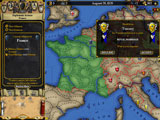 At
first glance, Europa Universalis may look like the old board game
"Risk" on Steroids, that's what I thought.
When I started playing though, I quickly changed my mind. If you must build EU up from an ideal of Risk, imagine that
you're playing it as a final test for your college studies in European
History, Religious studies, Economics, Wartime Strategy and
Government. It is by far
one of the most complex and historically accurate Strategy games ever
made. At
first glance, Europa Universalis may look like the old board game
"Risk" on Steroids, that's what I thought.
When I started playing though, I quickly changed my mind. If you must build EU up from an ideal of Risk, imagine that
you're playing it as a final test for your college studies in European
History, Religious studies, Economics, Wartime Strategy and
Government. It is by far
one of the most complex and historically accurate Strategy games ever
made.
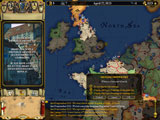 Europa
Universalis places you in at the head of a European nation, right in
the middle of the Age of Expansion.
The time period that the game covers begins at the discovery of
the new world in 1492 and concludes at the beginning of the Napoleonic
conquest in 1792. 300
years of European discovery, colonization, war, reform, and invention
set the stage for this massive and in depth game.
As monarch of a chosen European Power, you attempt to create a
veritable Superpower in your given timeline.
If you're successful and a little bit lucky, you can rule the
world. Otherwise, it's
back to the drawing board. The
game contains 7 pre-made scenarios, a tutorial and the ability for up
to 8 player LAN (or internet) action. Europa
Universalis places you in at the head of a European nation, right in
the middle of the Age of Expansion.
The time period that the game covers begins at the discovery of
the new world in 1492 and concludes at the beginning of the Napoleonic
conquest in 1792. 300
years of European discovery, colonization, war, reform, and invention
set the stage for this massive and in depth game.
As monarch of a chosen European Power, you attempt to create a
veritable Superpower in your given timeline.
If you're successful and a little bit lucky, you can rule the
world. Otherwise, it's
back to the drawing board. The
game contains 7 pre-made scenarios, a tutorial and the ability for up
to 8 player LAN (or internet) action.
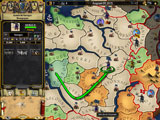 There
are so many aspects to the game, I really don't know where to begin.
I'll start with a brief explanation of the interface and how
it's used. The main
window contains a map of the world.
You can move this map around and zoom in and out.
The "fog of war" makes it so you can only see places
that you've already explored. To
the left of the map, there is a sidepanel that displays all kinds of
information. This is
where you balance your budget, determine your religious preference,
build cities, promote government officials, form alliances and start
wars. The lower
quarter of the screen is a log of events that have transpired over the
past several years. This
is handy to look back and determine where you've sent armies, who's
attacked you and why the heck you wanted to start a colony in Tunisia
(well, the event log might not help you with the "Why" but
it'll sure tell you that you did!)
All of your provinces, cities, colonies, armies and navies are
displayed on the map screen. This is where you can move armies and navies about, and
decide which province to focus on. There
are so many aspects to the game, I really don't know where to begin.
I'll start with a brief explanation of the interface and how
it's used. The main
window contains a map of the world.
You can move this map around and zoom in and out.
The "fog of war" makes it so you can only see places
that you've already explored. To
the left of the map, there is a sidepanel that displays all kinds of
information. This is
where you balance your budget, determine your religious preference,
build cities, promote government officials, form alliances and start
wars. The lower
quarter of the screen is a log of events that have transpired over the
past several years. This
is handy to look back and determine where you've sent armies, who's
attacked you and why the heck you wanted to start a colony in Tunisia
(well, the event log might not help you with the "Why" but
it'll sure tell you that you did!)
All of your provinces, cities, colonies, armies and navies are
displayed on the map screen. This is where you can move armies and navies about, and
decide which province to focus on.
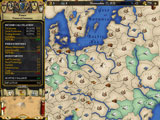 The
game is full of things to pay attention to, and you can set your own
pace. The "Semi-realtime"
environment that is described on the box basically comes down to the
fact that you can pause the game and tell 7 of your armies to invade 7
different nations and then hit "un-pause" and watch the Fit
hit the Shan. There are 8
game speed settings, the slowest being
"5 minutes real time = 1 month game time" and the
fastest "1 minute RT = 2 years GT", but I think that you've
have to be D.A.R.Y.L to be able to play at that speed.
Getting the right speed for you is important because if you
make it too slow, you'll be bored and if you make it too fast, you'll
drive yourself nutty. The
game is full of things to pay attention to, and you can set your own
pace. The "Semi-realtime"
environment that is described on the box basically comes down to the
fact that you can pause the game and tell 7 of your armies to invade 7
different nations and then hit "un-pause" and watch the Fit
hit the Shan. There are 8
game speed settings, the slowest being
"5 minutes real time = 1 month game time" and the
fastest "1 minute RT = 2 years GT", but I think that you've
have to be D.A.R.Y.L to be able to play at that speed.
Getting the right speed for you is important because if you
make it too slow, you'll be bored and if you make it too fast, you'll
drive yourself nutty.
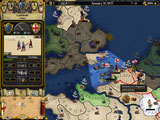 The
first thing that I did when I popped the game in was fire up the
Tutorial Scenario. It
seemed like a good straightforward way to learn how to play.
I lost. Bad.
OK, second time around, I've learned not to spend all of your
money on armies and cannons when you live on an Island.
I lost again. It wasn't so bad this time, but I still ran out of money and
had to start over. What's
up!? I don't take myself
to be a moron or anything, but this is the tutorial, it's supposed to
teach you how to play, not beat you down and spit in your face.
I took a walk and cooled of and came back for my third try at
the tutorial. They say
third times a charm, and this was no different.
This time I had a little experience under my belt and had a
pretty good handle on how the game worked, but it still took me
several hours to get through it. So I've made my point, there's a rather healthy
learning curve on the game, just don't think you're going to sit down
and win like you do with Mrs. Pac Man. The
first thing that I did when I popped the game in was fire up the
Tutorial Scenario. It
seemed like a good straightforward way to learn how to play.
I lost. Bad.
OK, second time around, I've learned not to spend all of your
money on armies and cannons when you live on an Island.
I lost again. It wasn't so bad this time, but I still ran out of money and
had to start over. What's
up!? I don't take myself
to be a moron or anything, but this is the tutorial, it's supposed to
teach you how to play, not beat you down and spit in your face.
I took a walk and cooled of and came back for my third try at
the tutorial. They say
third times a charm, and this was no different.
This time I had a little experience under my belt and had a
pretty good handle on how the game worked, but it still took me
several hours to get through it. So I've made my point, there's a rather healthy
learning curve on the game, just don't think you're going to sit down
and win like you do with Mrs. Pac Man.
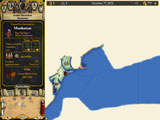 Once
I learned how to work my country's finances and be a competent
monarch, the game became much more interesting.
There are 5 areas of research that you can put funds towards. You can apply your hard earned gold toward army and navy
advances, trade development, national stability and infrastructure.
The game has the standard ladder of advancement, you can't make
cannons before you have gunpowder and you can't promote Governors
before you can promote Mayors. Army and Navy advancement are pretty straight forward, and
Trade Development pretty much speaks for itself.
It is Stability and Infrastructure that deserve a little
explanation. Stability is
the chance that your people are likely to turn on you.
If you live in a Catholic state and you all of a sudden decide
that you're going to be a Pagan nation, your townsfolk are not going
to take kindly to that, thus reducing your Stability.
On the other hand, if you create a fine arts museum so your
people can fill their minds with meaningful thoughts of peace, art and
tranquility, then you've got pretty good chances that they're not
going to want to impeach you(which doesn't happen, they'll just form a
rebellion and take control of a city.)
Your infrastructure is the makeup level of your government.
When you increase your infrastructure, you gain the ability to
turn a bailiff into a tax collector.
This helps to make each of your colonies and cities more
productive and profitable. Once
I learned how to work my country's finances and be a competent
monarch, the game became much more interesting.
There are 5 areas of research that you can put funds towards. You can apply your hard earned gold toward army and navy
advances, trade development, national stability and infrastructure.
The game has the standard ladder of advancement, you can't make
cannons before you have gunpowder and you can't promote Governors
before you can promote Mayors. Army and Navy advancement are pretty straight forward, and
Trade Development pretty much speaks for itself.
It is Stability and Infrastructure that deserve a little
explanation. Stability is
the chance that your people are likely to turn on you.
If you live in a Catholic state and you all of a sudden decide
that you're going to be a Pagan nation, your townsfolk are not going
to take kindly to that, thus reducing your Stability.
On the other hand, if you create a fine arts museum so your
people can fill their minds with meaningful thoughts of peace, art and
tranquility, then you've got pretty good chances that they're not
going to want to impeach you(which doesn't happen, they'll just form a
rebellion and take control of a city.)
Your infrastructure is the makeup level of your government.
When you increase your infrastructure, you gain the ability to
turn a bailiff into a tax collector.
This helps to make each of your colonies and cities more
productive and profitable.
Trade is
another big part of the game. Each
of your provinces produces various resources, from fish or wool to
gold or iron. In order to
make money from these productions, you need to have merchants that are
willing to sell these for you. Each
political area has a geographical center of trade that the cities,
colonies and traders report to. Your
nation makes money on a monthly basis from the merchants that it has
in various centers of trade. In
order to build up money to expand your nation and keep inflation down,
you must have a healthy trade market along with your standard tax
collections. In addition
to the reacting to the actions of other players (AI and/or Human),
there are also historical events that occur at various times during
the game. The Reformation
might happen (but no earlier than 1517) and cause a mass of your
provinces to turn their backs on Catholicism.
Maintaining a Catholic state could jeopardize your relations
with many of your provinces. Also,
changing your state religion to Protestant allows you to confiscate
church-state property for government use.
So after
taking a dive into the depths about the EU's complexity and
playability, let's take a look at its less impressive side:
graphics and sound.. Given
that the bulk of the game is made of a great big map and that 300
years of history went into the game, the graphics are slightly on the
poor side. The cities and
colonies are displayed in the sidebar, but all look very similar.
The armies are display "standing" on the map, but
that is about the only detail that is on the map.
The sound was also a part of the game that was undercut.
The game rarely makes a noise at all, but when you're least
expecting it, a massive clanging and yelling pours from your speakers.
That same clanging and yelling is played every time your armies
go to into battle and sometimes loops itself 3 or 4 times depending on
the length of the battle.
All in
all, Europa Universalis was an impressive game. Just the amount of historical research that went into the
game is mind-boggling. The politics, economic and wartime strategy are
detailed enough to teach a seasoned veteran a thing or two.
It does a great job of simulating the difficulty that 16th
century European monarchs went through and the greatness that they had
the potential to achieve. The
weaker parts of the game might not affect a hardcore strategy buff,
but it did lessen the experience for me. I think that it is definitely
a unique and fascinating game that has the potential to lead into a
new genre of strategy-simulation games.
Tim
Johnson |
